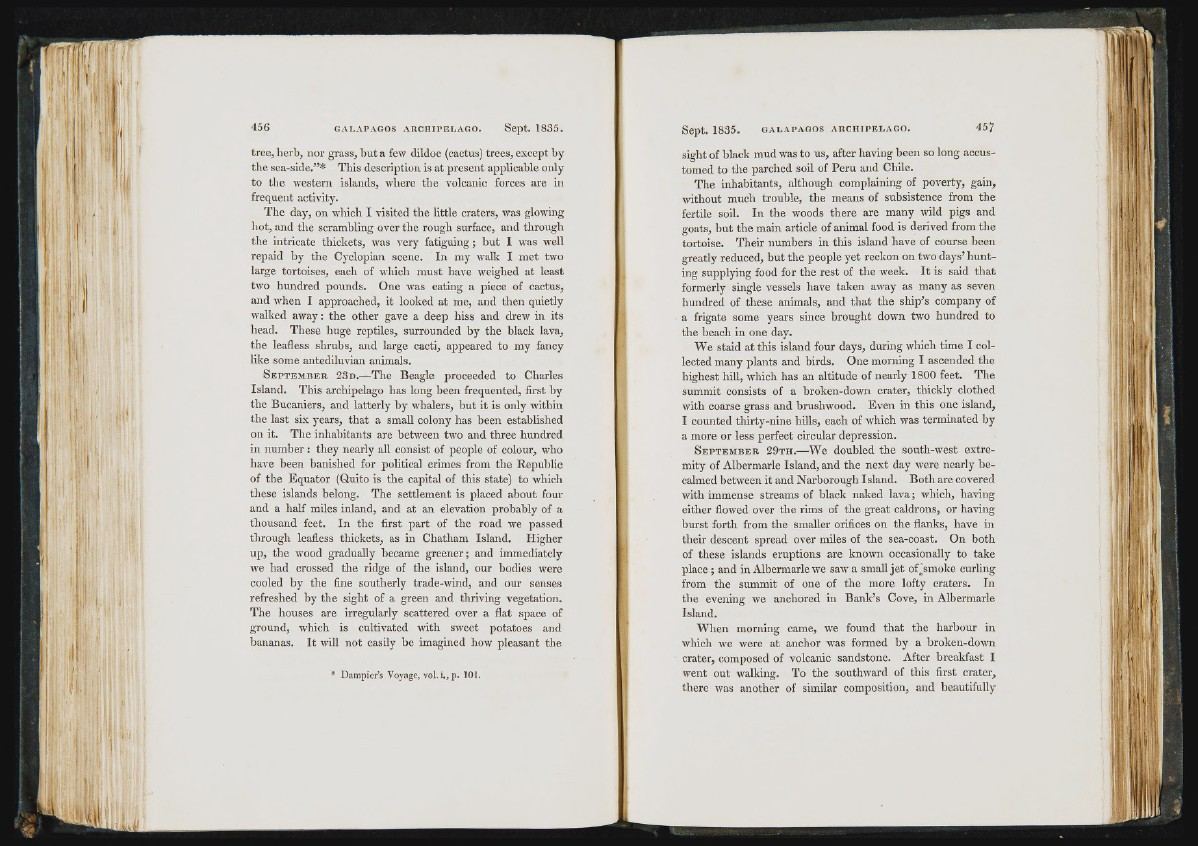
:7' i'
ri'
! , ' T i
tree, lierb, nor grass, but a few dildoe (cactus) trees, except by
the sea-side.” * This description is at present applicable only
to the western islands, where the volcanic forces are in
frequent activity.
The day, on which I visited the little craters, was glowing
hot, and the scrambling over the rough surface, and through
the intricate thickets, was very fatiguing; but I was well
repaid by the Cyclopian scene. In my walk I met two
large tortoises, each of which must have weighed at least
two hundred pounds. One was eating a piece of cactus,
and when I approached, it looked at me, and then quietly
walked away: the other gave a deep hiss and drew in its
head. These huge reptiles, surrounded by the black lava,
the leafless shrubs, and large cacti, appeared to my fancy
like some antediluvian animals.
S e p t e m b e r 2 3 d .—The Beagle proceeded to Charles
Island. This archipelago has long been frequented, first by
the Bucaniers, and latterly by whalers, but it is only within
the last six years, that a small colony has been estabhshed
on it. The inhabitants are between two and three hundred
in number: they nearly aU consist of people of colour, who
have been banished for political crimes from the Republic
of the Equator (Quito is the capital of this state) to which
these islands belong. The settlement is placed about four
and a half miles inland, and at an elevation probably of a
thousand feet. In the first part of the road we passed
through leafless thickets, as in Chatham Island. Higher
up, the wood gradually became greener; and immediately
we had crossed the ridge of the island, our bodies were
cooled by the fine southerly trade-wind, and our senses
refreshed by the sight of a green and thriving vegetation.
The houses are irregularly scattered over a flat space of
ground, which is cultivated with sweet potatoes and
bananas. It will not easily be imagined how pleasant the
* D am p ie r ’s Voyage, vol. i., p . lOJ.
sight of black mud was to us, after having been so long accustomed
to the parched soil of Peru and Chile.
The inhabitants, although complaining of poverty, gain,
without much trouble, the means of subsistence from the
fertile soil. In the woods there are many wild pigs and
goats, but the main article of animal food is derived from the
tortoise. Their numbers in this island have of course been
greatly reduced, but the people yet reckon on two days’ hunting
supplying food for the rest of the week. It is said that
formerly single vessels have taken away as many as seven
hundred of these animals, and that the ship’s company of
a frigate some years since brought down two hundred to
the beach in one day.
We staid at this island four days, during whioh time I collected
many plants and birds. One morning I ascended the
highest hill, which has an altitude of nearly 1800 feet. The
summit consists of a broken-down crater, thickly clothed
with coarse grass and brushwood. Even in this one island,
I counted thirty-nine hills, each of which was terminated by
a more or less perfect circular depression.
S e p t e m b e r 2 9 t h .—We doubled the south-west extremity
of Albermarle Island, and the next day were nearly becalmed
between it and Narborough Island. Both are covered
with immense streams of black naked lava; which, having
either flowed over the rims of the great caldrons, or having
burst forth from the smaller orifices on the flanks, have in
their descent spread over miles of the sea-coast. On both
of these islands eruptions are known occasionally to take
place ; and in Albermarle we saw a small jet offtsmoke curling
from the summit of one of the more lofty craters. In
the evening we anchored in Bank’s Cove, in Albermarle
Island.
When morning came, we found that the harbour in
which we were at anchor was formed by a broken-down
crater, composed of volcanic sandstone. After breakfast I
went out walking. To the southward of this first crater,
there was another of similar composition, and beautifully